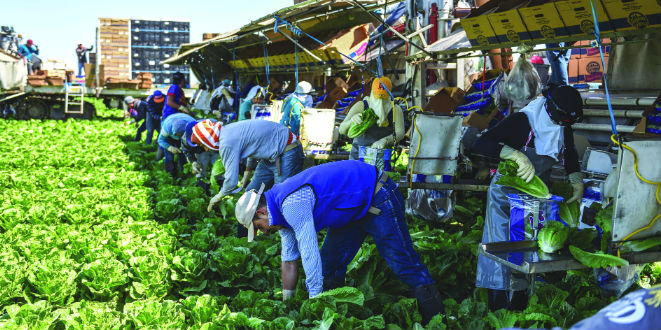

Jul 1, 2016Vegetable farm follows in patriarch’s footsteps
After farming in California’s Salinas Valley since the 1930s, agricultural legend George Tanimura died recently at age 100 – but Tanimura & Antle (T&A), the company he helped create, continues its momentum.
“Uncle George worked the fields until he was 95,” said his 66-year-old nephew Gary Tanimura, executive vice president of T&A. “He enjoyed growing, and that’s why he lived so long. It gave him a reason to get up every day and face the increasing challenges of modern agriculture.”


According to T&A, George Tanimura, eldest of 12 siblings, learned to thin iceberg lettuce while he was in grammar school. When his father died during the Great Depression, George started managing the family business – until World War II, when he and other members of his family were placed in an internment camp in Arizona, losing everything they had worked for.
After the war, the Tanimura family became manual laborers in Gilroy, California. They farmed small patches of land, saved the modest profits, and ultimately purchased their own land.
“I was 5 years old when I joined my dad and uncles cleaning onions in the field,” said Gary Tanimura, who went from hoeing weeds and moving sprinkler pipe to driving tractors and running the onion-packing shed.
In the late 1940s, the Tanimura family began a working relationship with Bud Antle, which joined Tanimura expertise in growing with Antle expertise in packing/marketing/shipping. In 1982, the relationship culminated in the formation of the Tanimura & Antle organization.
T&A is now the largest independent lettuce grower in the United States, with more than 60,000 acres of farmland in California, Arizona, Texas and Tennessee.
George Tanimura was responsible for many farming innovations, including introducing drip tape into row- crop agriculture, according to T&A.
“George is a true leader whose contributions to the produce industry will never be matched,” said T&A partner and senior vice president Mike Antle.
Bud Antle died in 1972. His son Robert (Bob) joined his father and grandfather Lester in their lettuce harvesting operation in the late 1940s, and ultimately became chief executive officer of all the Antle entities. Bob, who died in 2014, was responsible for produce industry initiatives such as wrapping fresh vegetables in the field, developing distribution centers for the introduction of wrapped lettuce and other source- packaged fruits and vegetables, and the production of crop transplants, according to T&A.


The Antle family’s farm history also began with California lettuce growing, starting out as packers in 1930, with Lester and Bud opening their own operation in 1942. WWII helped the Antle family, as soldiers overseas provided a new market for iceberg lettuce.
Iceberg is still one of the top crops, according to President and CEO Rick Antle, although productivity has dropped off in favor of other specialty lettuce.
“In 1985, iceberg represented 85 percent of what we grew. Today, it’s only 34 percent, because of a huge increase in romaine, mixed leaf and specialty artisan lettuces. We have to continually re-invent ourselves to stay on top of what shoppers and restaurants are looking for.”
“Every facet of the business has changed, and each year it gets more challenging to stay on top of it,” Gary Tanimura said. “We used to run ditch irrigation and use a siphon hose, then we graduated to furrow technology with irrigated pipes until the 1970s, when we got into sprinkler irrigation. When the drought of the 1980s hit, we were one of the first to get into drip irrigation, watering and fertilizing only what the crop actually needed. Now we’re looking ahead to transplant tape that will cut the work of 12 down to three employees.”
Rick Antle said it’s a constant process to stay on top of market, water, pest control and labor concerns.


“We’re on track for a California hourly wage of $16 to $18,” he said. “We’ve just finished building safe and affordable worker housing in Salinas. And while our manpower commitment runs from 2,000 a day to a seasonal 7,000 daily, our retention rate is over 85 percent. Ten percent of our employees have been with us for over 20 years. Some who started as pickers or tractor drivers are now managers, and they’re bringing on board the next generation of their family members.
“We continue to grow conventionally to supply a healthy salad bowl diet for Americans, and don’t export much because the rest of the world has learned how to grow their own. And we stay ahead of the curve by finding new, innovative ways to grow and harvest. The future is going to be about automation and minimizing hand labor to make the job easier and faster. In fact, we’ve increased our output by 20 percent over the last eight years by modifying machines, and there’s still more productivity per acre to be discovered that will save water, increase yields and produce more with less.”
Brian Antle, in his mid-30s, represents the youngest generation at T&A. As vice president of harvest operations, he has already put in 20 years on the farm.
“It’s no longer the day of planting a seed, growing a crop, boxing and shipping it,” he said. “We’re needing to work smarter, not harder, constantly trying to create and innovate. Gone are the days of guys who turned wrenches. Now, they have to be able to write computer code and read GPS devices. We need to speed up the process of installing automation and robotics at the field level, and if you’re not already thinking of new ways to do things, you’re going to get chewed up. At the end of the day, everybody’s got to eat. We just need to figure out how to grow our food in the future.”
— Lee Allen, VGN correspondent














